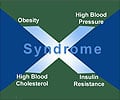Increased abdominal weight heightens the risk of metabolic disease, while weight gain in the thighs and other parts of the lower body, decreases the risk as volunteers demonstrated to researchers.

Researchers recruited 28 volunteers to the research study.
They were overfed for eight weeks, consuming giant candy bars, ice cream shakes, high-calorie drinks and almost anything else they wanted to eat.
On average, participants put on 2.5 kilograms (kg) or 5.5 pounds (lbs) of upper body fat and 1.5 kg or 3.3 lbs of lower body fat.
Even prior to fat gain, the preadipocytes (cells with the ability to become mature fat cells) in the upper body showed an increase in RNA messages which prompt proteins to synthesize fat.
Fifteen men and 13 women participated in the study. Researchers measured body fat and fat cell size before and after the eight weeks of overeating.
Advertisement
It also supports the idea that increased capacity to produce lower-body fat cells creates some form of protection to the upper body and potentially helps prevent metabolic disease which can lead to diabetes and other complications.
Advertisement
Source-ANI










